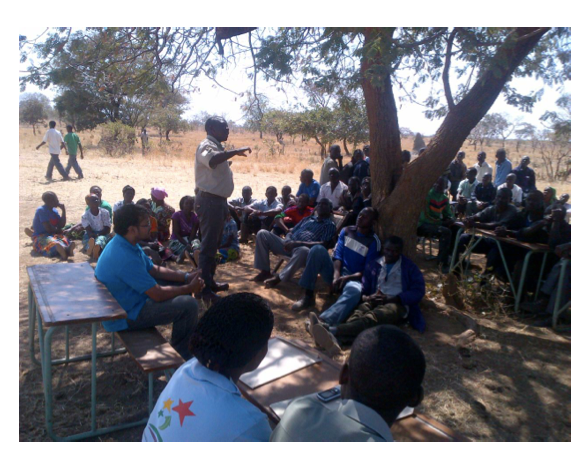By Emily Black
The 886 million Africans who depend on subsistence agriculture are highly vulnerable to weather-related agricultural risk. This vulnerability is exacerbated by a lack of access to insurance. A cheap and practical alternative to traditional insurance is weather index insurance (WII). Rather than compensating a proven loss, WII pays out in the event of a weather index being breached.
Although in principle WII could be provided to millions farmers globally, until recently cover has been restricted to those who live near a suitable weather station. This is especially relevant for Africa, where only ~3% of the population live near a rain gauge with a sufficiently long record for the assessment of risk. In some parts of the continent, moreover, this figure is far lower.
Figure 1: Explaining TAMSAT-based WII to farmers in Zambia (photograph courtesy of Agrotosh Mookerjee)
Satellite-based rainfall estimates, such as those issued through the University of Reading’s TAMSAT programme, provide a means of extending WII to farmers who do not live near a rain gauge. Last year, pilot TAMSAT-based WII schemes were operated in several African countries – covering approximately 45,000 farmers (Figure 1). These schemes have already had a tangible impact. In Zambia, for example, fair pay outs helped over 3000 farmers to weather a severe drought (Figure 2).
Figure 2: TAMSAT rainfall anomalies for March-May 2013 – showing a large rainfall deficit over Zambia (TAMSAT)
There remain hurdles to the widespread uptake of WII in Africa. Even carefully designed weather indices are only a proxy for agricultural losses. When indices are based on remotely sensed data, inevitable mismatches with weather ‘on the ground’ create an extra layer of uncertainty. Careful assessment of the TAMSAT rainfall estimation method’s ability to capture variability in candidate weather indices is thus key to developing robust TAMSAT-based WII products.
Current research within the TAMSAT group is focused on improving our rainfall estimates, and on relating TAMSAT-based indices of drought to the wetness of the soil. Over the next few years, we hope that these innovations will enable us to offer reliable TAMSAT-based WII to farmers throughout Africa.


